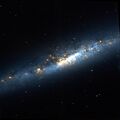Astronomy:NGC 7090
| NGC 7090 | |
|---|---|
 NGC 7090 image from the Hubble Space Telescope combines orange light (colored blue here), infrared (colored red) and emissions from glowing hydrogen gas (also in red)[1][2] | |
| Observation data (J2000 epoch) | |
| Constellation | Indus |
| Right ascension | 21h 36m 28.865s[3] |
| Declination | −54° 33′ 26.35″[3] |
| Redshift | 0.002859±0.000020[4] |
| Helio radial velocity | 846 km/s[5] |
| Distance | 31.0 Mly (9.5 Mpc)[6] |
| Apparent magnitude (V) | 10.51[7] |
| Characteristics | |
| Type | Scd[8] |
| Mass | Stellar: 5.47×109[6] M☉ |
| Other designations | |
| IRAS 21329-5446, NGC 7090[7] | |
NGC 7090 is a spiral galaxy[8] in the southern constellation of Indus located about 31 million light-years away.[6] English astronomer John Herschel first observed this galaxy on 4 October 1834.[1][2]
The morphological class of NGC 7090 is Scd,[8] indicating it is a spiral with loosely-wound and somewhat disorganized arms. The galactic plane is inclined at an angle of 89° to the line of sight from the Earth,[8] giving it an edge-on view. The combined mass of the stars in this galaxy is 5.5 billion times the mass of the Sun (M☉), while the star formation rate is ~0.5 M☉·yr−1.[6] As a result of star formation, the diffuse ionized gas in the galaxy has a complex organization, showing filaments, bubbles, and super-shells.[9]
Three transient ultraluminous X-ray sources have been detected in NGC 7090.[10][11]
Gallery
NGC 7090 by Hubble Space Telescope
References
- ↑ 1.0 1.1 "Hubble Sees NGC 7090 — An actively star-forming galaxy". NASA. September 14, 2012. https://www.nasa.gov/mission_pages/hubble/science/ngc7090.html.
- ↑ 2.0 2.1 "NGC 7090 — An actively star-forming galaxy". ESA/Hubble Picture of the Week. http://www.spacetelescope.org/images/potw1237a/.
- ↑ 3.0 3.1 Skrutskie, Michael F. et al. (1 February 2006). "The Two Micron All Sky Survey (2MASS)". The Astronomical Journal 131 (2): 1163–1183. doi:10.1086/498708. ISSN 0004-6256. Bibcode: 2006AJ....131.1163S.
- ↑ de Vaucouleurs, G. et al. (1991), Third reference catalogue of bright galaxies, 9, New York: Springer-Verlag
- ↑ Tully, R. Brent et al. (August 3, 2016). "COSMICFLOWS-3". The Astronomical Journal 152 (2): 50. doi:10.3847/0004-6256/152/2/50. Bibcode: 2016AJ....152...50T.
- ↑ 6.0 6.1 6.2 6.3 Lianou, S. et al. (November 2019). "Dust properties and star formation of approximately a thousand local galaxies". Astronomy & Astrophysics 631: 19. doi:10.1051/0004-6361/201834553. A38. Bibcode: 2019A&A...631A..38L.
- ↑ 7.0 7.1 "NGC 7090". SIMBAD. Centre de données astronomiques de Strasbourg. http://simbad.u-strasbg.fr/simbad/sim-basic?Ident=NGC+7090.
- ↑ 8.0 8.1 8.2 8.3 Heesen, Volker et al. (May 2016). "Advective and diffusive cosmic ray transport in galactic haloes". Monthly Notices of the Royal Astronomical Society 458 (1): 332–353. doi:10.1093/mnras/stw360. Bibcode: 2016MNRAS.458..332H.
- ↑ Rossa, J. et al. (September 2012). "The Morphological Diversity of DIG in Halos of Edge-on Spirals as Revealed by HST/ACS". in de Avillez, M.A.. The Role of the Disk-Halo Interaction in Galaxy Evolution: Outflow vs. Infall?. EAS Publication Series. 56. pp. 221–224. doi:10.1051/eas/1256035. Bibcode: 2012EAS....56..221R.
- ↑ Liu, Zhu et al. (July 2019). "X-ray properties of two transient ULX candidates in galaxy NGC 7090". Monthly Notices of the Royal Astronomical Society 486 (4): 5709–5715. doi:10.1093/mnras/stz1194. Bibcode: 2019MNRAS.486.5709L.
- ↑ Walton, D. J. et al. (February 2021). "A new transient ultraluminous X-ray source in NGC 7090". Monthly Notices of the Royal Astronomical Society 501 (1): 1002–1012. doi:10.1093/mnras/staa3666. Bibcode: 2021MNRAS.501.1002W.
External links
Coordinates: ![]() 21h 36m 28.865s, −54° 33′ 26.35″
21h 36m 28.865s, −54° 33′ 26.35″
 |



